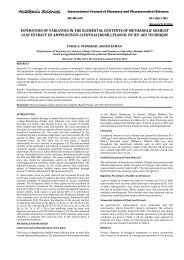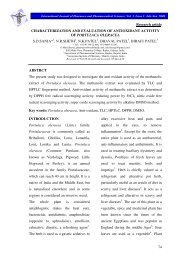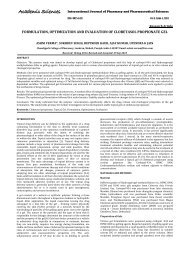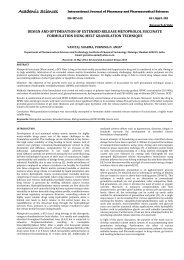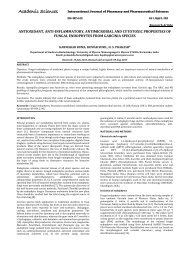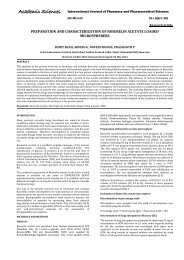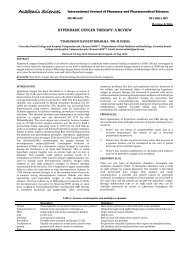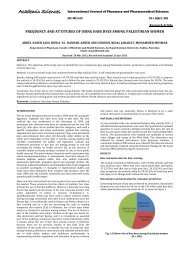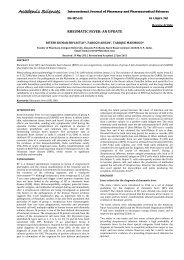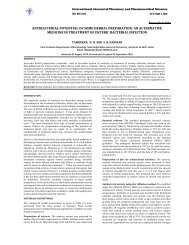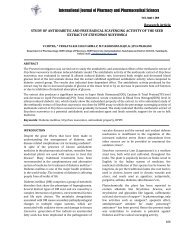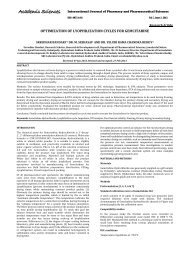(dennst) nicols.var paeonifolius - International Journal of Pharmacy ...
(dennst) nicols.var paeonifolius - International Journal of Pharmacy ...
(dennst) nicols.var paeonifolius - International Journal of Pharmacy ...
You also want an ePaper? Increase the reach of your titles
YUMPU automatically turns print PDFs into web optimized ePapers that Google loves.
The ash values, total ash, acid insoluble ash and water soluble ash<br />
are particularly important in the evaluation <strong>of</strong> purity <strong>of</strong> drugs12 .<br />
Total ash content, water soluble ash,acid insoluble ash, alcohol<br />
soluble extractive and water soluble extractive were found to be<br />
9.16%, 4.86%, 3.66%,5.36% and 8.36% respectively. Ash and<br />
extractive values signify the amount <strong>of</strong> inorganic impurities,<br />
resistant materials like sand, soil and stone particles in crude drugs.<br />
The ash value <strong>of</strong> medicinal plants reflects the carbonate, phosphates,<br />
oxides, silicates and silica13 . Evaluation <strong>of</strong> ash and extractive values<br />
<strong>of</strong> crude drugs help in the identification and determination <strong>of</strong> its<br />
purity and quality14. Phytochemical analysis is very useful in the evaluation <strong>of</strong> active<br />
biological components <strong>of</strong> medicinal plants. The qualitative analysis<br />
Madhavan et al.<br />
Int J Pharm Pharm Sci, Vol 4, Suppl 5, 238-240<br />
<strong>of</strong> the powdered corms <strong>of</strong> Amorphophallus <strong>paeonifolius</strong> species<br />
showed the presence <strong>of</strong> phytochemicals such as alkaloids,<br />
flavonoids, phenolic compounds, steroids, saponins and the primary<br />
metabolites namely proteins, starch, carbohydrate(Table 1).<br />
Phytochemicals such as saponins, terpenoids, flavonoids, tannins,<br />
steroids and alkaloids have anti-inflammatory effects15<br />
. Presence <strong>of</strong><br />
phenols indicates the plant ability for antimicrobial activities16 . The<br />
good antioxidant activity and hypoglycemic activities can be<br />
attributed to the presence <strong>of</strong> flavonoids17 . Alkaloids acts as an<br />
analgesic drug18 . Alkaloids can increase nutrient absorption and<br />
blood circulation, hypoglycemic activities reduce pain and stimulate<br />
nerve system as it has narcotic effect19 . Saponins helps in controlling<br />
cholesterol, antidiabetic properties20 . The steroids and saponins are<br />
responsible for central nervous system activities21. Table 1: Preliminary screening <strong>of</strong> primary and secondary metabolites from Amorphophallus <strong>paeonifolius</strong> (Dennst.) Nicols.<strong>var</strong> <strong>paeonifolius</strong><br />
Primary/Secondary Metabolites Name <strong>of</strong> the Test Powdered tuber Observations<br />
Carbohydrates Fehling Test ++ Red ppt<br />
Starch Iodine Test +++ Blue colouration<br />
Sugar Antrone Reagent Test +++ Blue Black Colouration<br />
Proteins Lowry’s Method ++ Blue colouration<br />
Aminoacids Ninhydrin Test _ No violet or purple colour<br />
Fats Filter paper Test _ No oil stains on filter paper<br />
Quinone NaOH Test - No Red Colouration<br />
Cardiac glycoside Ferric Chloride Test - No green Blue ppt<br />
Steroids Liebermann-Burchard Test ++ Blue Green Ring<br />
Flavonoids Ethylacetate Test ++ Yellow colouration<br />
Phenols Folin Test +++ Blue coluration<br />
Saponins Foam Test ++ Froth appearence<br />
Alkaloids Ammoniacal test ++ Creamish PPt<br />
+ indicates the intensity <strong>of</strong> occurrence <strong>of</strong> the compound tested; - absence <strong>of</strong> metabolite<br />
Table 2: Flourescence analysis <strong>of</strong> powdered rhizome <strong>of</strong> Amorphophallus <strong>paeonifolius</strong> (Dennst.) Nicols.<strong>var</strong> <strong>paeonifolius</strong> .<br />
Powdered Drug Visible/Day light UV 254 nm (Short) UV 365 nm (LONG)<br />
Powder as such Light brown Black Black<br />
Powder + 1M NaOH Dark brown Black Dark blue<br />
Powder + 1% Picric Acid Light brown Black Dark blue<br />
Powder + Acetic acid Dark brown Black Grayish blue<br />
Powder + 1M HCl Dark brown Black Blackish blue<br />
Powder + 5% Iodine Creamish brown Black Dark blue<br />
Powder + 5% FeCl 3 Blackish brown<br />
Black black<br />
Powder + HNO 3 + 25% NH 3 Dark brown<br />
Black Blackish blue<br />
Powder + Methanol Dark brown Black Dark blue<br />
Powder + 50% HNO 3 Yellowish brown<br />
Black Dark blue<br />
Powder + 1M H 2SO 4 Dark brown<br />
Black black<br />
Powder +Conc HNO 3 Blackish brown<br />
Black Dark blue<br />
Powder + 10% potassium dichromate soln Yellowish brown Black black<br />
Powder + 25% Liquid NH3 Blackish brown<br />
Black Dark blue<br />
Fluorescence analysis is the phenomenon exhibited by <strong>var</strong>ious<br />
chemical constituents present in the plant material under UV<br />
light(Table 2). This can be used to characterise the crude drugs.<br />
Thus crude drug is <strong>of</strong>ten assessed qualitatively and this forms an<br />
important parameter <strong>of</strong> pharmacognostical evaluation.<br />
The data obtained for elemental concentrations <strong>of</strong> the plant tuber<br />
can be used to evaluate the potentiality <strong>of</strong> these in their medicinal<br />
preparations 22 .The analysis <strong>of</strong> element in the tuber (Table 3)<br />
indicated the presence <strong>of</strong> elements in the decreasing order with<br />
maximum value for Sodium and least value <strong>of</strong> Magnesium, Na<br />
>Fe>Sr>C>Mn>Cu>H>N>K>Ca>S>Mg. These elements play a vital<br />
role in the formation <strong>of</strong> secondary metabolites which are<br />
responsible for pharmacological actions <strong>of</strong> medicinal plants23. Sodium and potassium form the major essential elements and is<br />
present in the plant tuber. Sodium is necessary in production <strong>of</strong><br />
energy amino acid and glucose transport. A high concentration <strong>of</strong><br />
sodium is seen in the tuber <strong>of</strong> Amorphophallus. Magnesium<br />
represents the element with least concentration.Magnesium<br />
improves insulin sensitivity protect diabetes and its complications<br />
and reduce blood pressure.<br />
Table 3: Elements analysis <strong>of</strong> rhizome <strong>of</strong> Amorphophallus<br />
<strong>paeonifolius</strong> (Dennst.) Nicols.<strong>var</strong> <strong>paeonifolius</strong> .<br />
Elements Mg/g<br />
Nitrogen 2.48<br />
Carbon 41.59<br />
Sulphur 0.44<br />
Hydrogen 6.11<br />
Calcium 0.723<br />
Pottassium 0.939<br />
Magnesium 0.130<br />
Copper 19.35<br />
Iron 224.22<br />
Manganese 23.1<br />
Sodium 699.7<br />
Strontium 70.4<br />
239



